#Thailand Bangkok Pattaya Phuket WhatsHappeningInThailand
Text
TransferWise Review: Transfer Money & Send it Abroad
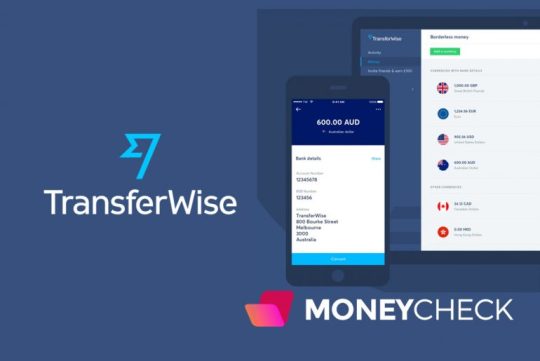
We take a close look at Transferwise for Money Transfers & Sending Money Abroad - Is it Safe? What are the Fees? Everything You Need to Know
In a time not so long ago, attempting to send and receive money on a cross-border basis was a financial and logistical nightmare.
Irrespective of whether you use your local bank or a money transfer company like Western Union – you would not only be accustomed to hefty fees and long delays, but you’d also need to sign countless documents.
Fast forward to 2019 and it is now possible to transfer funds overseas at the click of a button – both quickly and cheaply. One of the leading online platforms in this respect is TransferWise.
As such, if you’re thinking about using Transferwise for your international transfer needs, be sure to read our in-depth review.
We’ve covered everything that you need to know, such as how the platform works, fees, transfer times, regulation, safety, and more.
Let’s start by getting an overview of what Transferwise is.

Transferwise Money Transfers - Visit
Transfer Type
Online Only
Fees
$2 up to $400 / ~0.5% Over $400
Transfer Speed
From Same Day
Mobile App
Min Transfer
£1 / $1
Visit Transferwise
What is TransferWise?
Launched in 2011 and founded by Taavet Hinriku and Kristo Käärmann – Transferwise is a money transfer service company that operates purely online.
The founders launched the platform with the view of revolutionizing the cross-border payments sector, insofar that they wanted to bring more competitive foreign exchange fees to everyday consumers.
In order to achieve this, the overarching concept of TransferWise that they offer customers the mid-market exchange rate on their chosen currency pairs.
This is in stark contrast to traditional financial institutions, who will all-but certainly add a percentage on top of the market rate that they get. We’ll explain how this works in more detail further down.
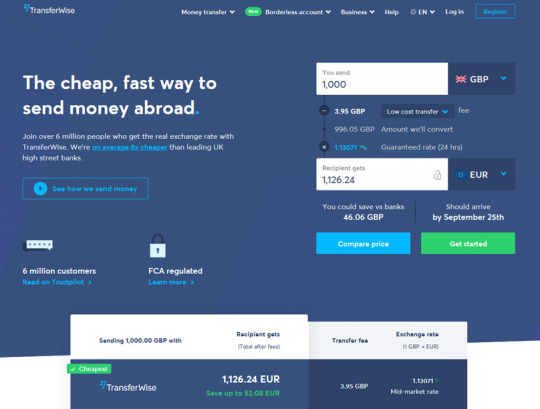
Nevertheless, the TransferWise platform has become so popular that it now serves 6 million customers across 59 individual counties.
With offices now located in 12 different nations, the platform also claims that it facilitates $4 billion worth of international transfers each and every month, subsequently saving customers $1 billion per year – had they gone the traditional route.
As the company behind TransferWise has grown in size, its product range has followed suit. One such example of this is its Borderless Account offering.
This makes the money transfer process is easier, not least because account holders will have access to a fully-fledged Prepaid Mastercard.
As we will discuss further down, the Borderless Account also comes with localized bank account numbers across multiple jurisdictions, including the US, UK, Australia, and New Zealand.
So now that you have an idea of what it is that TransferWise does, in the next section we are going to unravel how the platform is able to offer super-low rates.
Why is TransferWise so Much Cheaper?
First and foremost, in order to understand how TransferWise is able to under-cut traditional banks and money transfer companies, it is important to gain an understanding of how cross-border exchange rates typically work.
Mid-Market Rates
Otherwise referred to as the interbank rate – the mid-market rate is the difference between the buy and sell price of two native currencies. In layman terms, this is what an institutional buyer is prepared to pay for the currency, against the price that an institutional seller is prepared to sell it for.
After all, it is large-scale banks and financial institutions that ultimately drive real-time currency prices.
Let’s take the US Dollar (USD) and British Pound as an example currency pair (GBP/USD).
If an institutional buyer was prepared to pay 1.4 USD against GBP, and an institutional seller was prepared to sell it at 1.6 USD against GBP, then the mid-market rate would be 1.5 USD/GBP.
With that being said, when you search for your chosen exchange rate on Google, the rate that you are presented is in fact the mid-market rate.
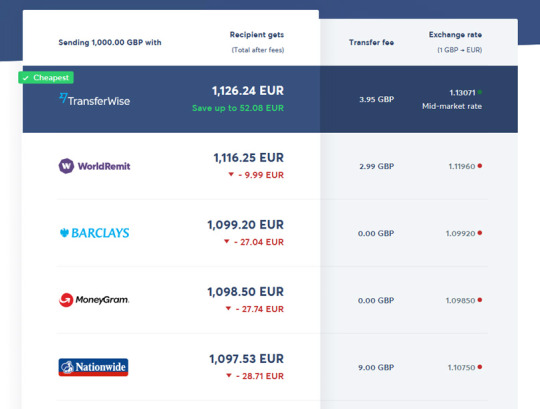
Do I get the Mid-Market Rate?
Although the difference between the buy and sell rate will dictate the mid-market rate that large-scale institutions are able to get – unfortunately, this is not the rate that everyday consumers will get when they transfer money abroad.
On the contrary, you’ll pay a hefty mark-up on this rate, subsequently netting banks a somewhat tidy profit.
In terms of the charge itself, this will typically be a percentage mark-up, a flat fee, and a combination of the two. It is not uncommon for money transfer companies to offer something along the lines of ‘0% Commission’ or ‘No Fee Markups’.
However, while you might not pay a fee per-say, you do this indirectly with the specific exchange rate that you are offered.
TransferWise themselves offer a simple example of how this can impact you, which we’ve highlighted below:
- The current GBP/EUR mid-market rate is £1 = €1.43
- As such, by converting £1,000 into Euros, you should receive €1,430.
- However, you only receive €1,370, meaning that you effectively receive a rate of 1.37, not 1.43.
- The difference between the two rates (1.37 and 1.43) is the profit made by the underlying transfer company.
So now that you know how the mid-market rate works – and that you’ll typically receive a much worse exchange rate than what traditional banks are able to get themselves, let’s explore how much TransferWise costs in comparison.
How Much Does TransferWise Cost?
First and foremost, it is important to note that the specific fees charged by TransferWise will vary considerably depending on a number of key factors.
Notably, this includes the amount that you are sending, the currency you are sending, the currency the beneficiary is receiving, and how you intend on funding the transfer. As such, the best way to gauge just how much TransferWise costs is to look at some examples.
Example 1: Sending $1,000 from the US to India
At the time of writing, the mid-market rate on USD/IDR is 71.2 Rupees for every $1 that you exchange. This means that a $1,000 exchange at the mid-market rate would yield 71,200 IDR.
When using TransferWise for the same exchange, the beneficiary would receive 70,429 IDR. Breaking the fees down, this includes a $7.08 fixed fee charged by TransferWise and a $2 ACH fee to fund the transfer.
However, if you were to use a wire transfer, this would cost $5.34. Moreover, a debit and credit card deposit would cost $7.44 and $32.88, respectively. As such, you would be best advised to avoid using a credit card to fund your TransferWise transfer.

Nevertheless, the above example illustrates that you do in fact get the mid-market rate from TransferWise, less the aforementioned $9.08 fees (more if you don’t use ACH) – which is then indirectly built into the exchange rate.
In comparison, the exact same transfer with leading money transfer company MoneyGram would leave the receiver with just 69,425 IDR. This includes a $14.99 debit/credit card fee.
Example 2: Sending $1,000 to the UK
In our second example, we looked at how much it would cost to send $1,000 to the UK. At the time of the comparison, TransferWise quoted £0.81 for every $1 that you transfer. Built within this fee was a $7.21 TransferWise fee, which included the $2 ACH deposit.
With that being said, a $1,000 transfer would leave the beneficiary with £804.15. In comparison, although Western Union only charged a $2.99 fixed fee for the very same transfer, the exchange rate that we were quoted was £0.76 per $1.

As such, the beneficiary only receives £760.10. In comparison to using TransferWise, the Western Union transfer would leave the receiver with £44.05 less.
This example further highlights the point that we discussed earlier on hidden fees, insofar that although Western Union charges a lower fixed fee, they are actually more expensive as the exchange rate on offer is significantly less favorable in comparison to TransferWise.
Example 3: TransferWise vs a Traditional US Bank
Although the exact fees will vary depending on which bank you use, this is by far the worst way of transferring funds overseas. First and foremost, you will likely need to visit your local branch and sign a range of documents before the bank is able to execute the transfer.
Next, as the bank will need to use the SWIFT network, the beneficiary will likely need to wait 3 working days before they receive the funds.
Finally – and perhaps most importantly, you’ll pay huge fees – both directly and indirectly.
Firstly, financial institutions like Chase Bank will typically charge a fixed fee of $45 for facilitating an in-branch international transfer. Secondly, it would not be unusual for the bank to add 3%-5% on top of the mid-market rate that they are able to get.
As such, irrespective of where you are sending money to and for how much, TransferWise will always be cheaper.
How Does the Money Transfer Process Work?
So now that you know how much cheaper TransferWise is in comparison to traditional banks and established money transfer companies, let’s take a look at how the process typically works.
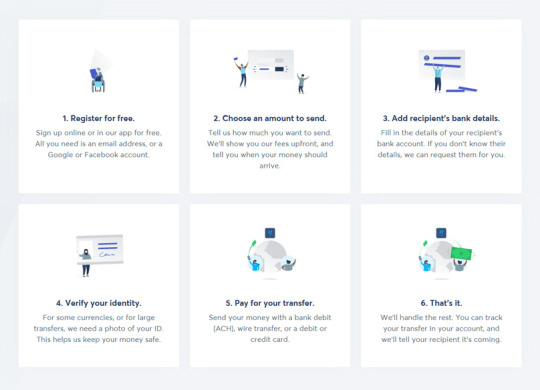
Step 1: Enter transfer details
Your first port of call will be to head over to the TransferWise homepage and choose the currency that you are sending, and the currency that the beneficiary will be receiving.
For example, if you’re looking to send money from the US to your friend in Germany, then you’ll need to select USD and EUR.
The great thing about TransferWise is that they are very transparent on how much they charge.
As such, when you enter the amount that you want to send, TransferWise will not only show you how much the beneficiary will receive, but you can also break the fees down by clicking on ‘See Calculation’.
If you’re happy with the rate offered on screen, click on the ‘Get Started’ button.
Step 2: Enter the details of the beneficiary
The next stage will require you to enter the bank account details of the person you want to send the money to.
Much in the same way as any other bank transfer, you’ll need to enter the receiver’s full name, BIC number, and IBAN. You will also be prompted to enter a reference number of your choosing.
Make sure that these details are correct, as TransferWise will not be held responsible in the event that the funds are sent to the wrong account.
Step 3: Choose your payment method
You will now be asked how you would like to fund the payment. Don’t forget, TransferWise is an online-only company, so you won’t be able to deposit funds in-person.
Nevertheless, the specific payment options available to you will depend on where you are located. If you’re based in the US, then you can pay via ACH, wire transfer, debit card, or credit card.
As we briefly noted earlier, ACH is by far the cheapest option, as it only costs $2 per transfer.
Step 4: Transfer the funds
If you are using a debit or credit card, then you simply need to follow the on-screen instructions, as the entire process is facilitated by TransferWise. However, if you’re looking to pay via ACH or a bank wire, then you’ll need to complete the process externally.
TransferWise will give you the account details that you need to send the funds to, alongside a unique reference number.
It is imperative that you include the reference number within your transfer, otherwise, this will delay the transaction.
Moreover, you also need to ensure that the name associated with your bank account matches the name you entered with TransferWise, and the amount that you transfer needs to match the TransferWise amount to the ‘cent’.
Step 5: Wait for email confirmation
Once you have made the required transfer (or paid by debit/credit card), TransferWise will notify you via email once the funds have been received.
Once they have, TransferWise will then execute your transfer. We’ll discuss time-frames in more detail in the next section.
How Long do TransferWise Payments Take?
Once again, the amount of time that it will take for the beneficiary to receive the money will depend on a number of factors.
Read the full article
0 notes
Text
Rabies out of control, official Thai stats 'untruthful'

RABIES OUTBREAK in #Thailand is far from being under control, a medical expert has warned, even though official statistics from the Livestock Development Department show a declining rate of rabies infection.
Livestock Development Department director-general Sorawit Thaneeto previously said most rabies infection control goals had been met, while the number of rabies-positive cases in animals were also decreasing.
Taken together, the figures signified satisfactory progress in the government’s efforts to eradicate the disease, said Sorawit.
A joint operation between Livestock Development Department and Local Administration Department has since last October vaccinated 8.39 million dogs and cats nationwide, and has already surpassed this year’s goal of 8.24 million animals.
This marked good progress in disease control efforts, said Sorawit, adding that the number of provinces with continuing reports of rabies infections had been reduced to 20.
The number of new rabies infections in animals was also decreasing, and the infection rate this month was below the same period of last year, he said.
https://bangkokjack.com/2019/04/17/thailand-north-korean-model/
The rabies infection monitoring system also reported that positive rabies cases were found in 54 out of 77 provinces of Thailand, with Surin having the highest disease prevalence.
The rabies outbreak was still active in Saraburi, Chonburi, Samut Prakan, Chaiyaphom, Nakhon Ratchasima, Buri Ram, Yasothon, Surin, Amnart Chareon, Kalasin, Khon Kaen, Mukdahan, Roi Et, Nong Khai, Prachuap Khiri Khan, Phetchaburi, Samut Songkram, Nakhon Si Thammarat, Ranong, and Songkhla provinces.
An infectious-disease expert said there were still reasons to be concerned. Rabies infections in local areas were not completely under control, said Dr Thiravat Hemachudha, head of the Emerging Infectious Disease Health Science Centre at Chulalongkorn University’s Faculty of Medicine.
His observations suggested the information from new cases in animals were ambiguous, he said.
This information matched with reports from local medical practitioners, who said they continued to face a high infection rate of rabies among stray animals.
Thiravat said that the infection-rate statistics provided by the authorities were misleading. The reduced number of cases of new rabies infections in animals was a result of a lower number of samples being sent to laboratories for testing, he said.
“I urge the Livestock Development Department to inform the public with accurate data and not try to hide the truth just to prevent public panic,” he said.
“We must face the reality in order to solve this problem.” - The Nation
Read the full article
0 notes
Text
What It’s Like to Visit Bangkok Right Now

When Thailand shut its borders to foreign visitors in March 2020, the city that was once the world's most visited felt as if it had lost its soul almost overnight.
Without tourists, Bangkok simply didn’t feel like Bangkok anymore. But after nearly two years, the capital is finally opening up to the world again.
On Feb. 1, Thailand’s border reopened to vaccinated travelers from every country as part of the government's shift from a Covid-zero approach to considering the virus endemic.
Travelers will need only a negative PCR lab result before arrival and agree to two more PCR tests after landing—one upon entry and another on their fifth day in Thailand.
And while this isn’t the first time travelers have been allowed back in, it marks a strong departure from previous attempts to restart tourism, which required travelers to jump through such substantial hoops as quarantining for seven to 14 days or being confined to an island for a period of a week or more after their arrival.
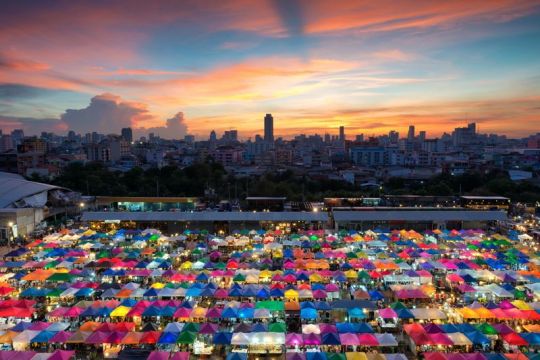
A night market on Ratchadapisek Road. Photographer: Kiyoshi Hijiki/Moment RF
The Thai government expects as many as 15 million foreign visitors this year. That’s a far cry from the nearly 40 million who came in 2019, the year before the pandemic, but it’s a lot more than last year’s 428,000 arrivals.
As it stands, Thailand has vaccinated 70% of its residents, with about 20% of its total population having already received third or fourth shots.
Bangkok has relaxed its Covid-19 protocols so that people can once again eat in restaurants, see movies, or enjoy nightlife—though you still need to strictly follow mask mandates.
There hasn’t been an omicron surge like those in the U.S. or Europe, and health officials say new infections are within manageable levels.
Although Bangkok locals are getting back out and about, making the city feel alive again, visitors will still find a city that’s quieter—but just as energetic—than they remember.
The crowds will return, so 2022 is the time to enjoy the city while it’s relatively empty and help business owners get back on their feet.
The Dining Scene

The serene dining room at Côte by Mauro Colagreco. Source: Côte by Mauro Colagreco
Bangkok is known for a food scene that ranges from pad thai, a cheap but beloved national dish peddled from street stalls, to high-end restaurants with elaborate tasting menus.
Across the spectrum they’ve been starved for business, not just because of the absence of diners from abroad but because domestic patrons were kept away through months of lockdowns and harsh restrictions. Those have been lifted.
In Bangkok, there's no longer a capacity limit for indoor dining, but temperature checks will be required and, in most places, staff is required to be vaccinated and undergo regular Covid tests.
Some famous spots such as Bo.lan—known for classic Thai dishes that used ingredients such as fermented fish or banana blossoms–have closed down.
But many local favorites were able to endure, including the almost impossible-to-book Sorn (22-course southern Thai cuisine), Sühring (contemporary German and European fare in a 1970s villa), and Jay Fai (Michelin-starred street food, with every dish is made by Jay Fai herself).
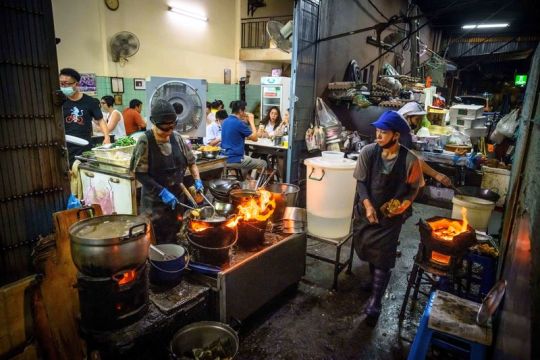
The Queen of Street Food, Michelin star chef Jay Fai prepares food at her restaurant in downtown Bangkok. Photographer: Mladen Antonov/AFP/Getty Images
With the loosening of restrictions on travel and businesses, chefs and restaurateurs are again investing in new businesses: Among the most-anticipated 2022 openings will be Maison Dunand, a fine-dining restaurant and contemporary bistro by French chef Arnaud Dunand Sauthier, formerly of Le Normandie at the Mandarin Oriental Bangkok.
Scheduled to open this spring, it’s one of several restaurants that have chosen the Sathon area. Côte by Mauro Colagreco, which opened in Bangkok amid the pandemic, is located just off Sathon Road.
While plastic Covid partitions between spread-apart tables have disappeared in many cities, they can still be found in many Bangkok restaurants; outdoor dining is less common outside street stalls, given Bangkok’s heat.
Famous vendors have taken a big hit but are bouncing back in some areas. The best neighborhood to walk around and sample options is Chinatown, where hundreds of vendors are all within walking distance and where food options range from Chinese and Thai food to seafood and desserts.
Culture Makes a Comeback
With few remaining restrictions, navigating the next phase of the pandemic in Bangkok is a game of choose-your-own-adventure.

The gate to the Phra Mondop Scripture Hall at Wat Po. Photographer: Manfred Gottschalk/Stone RF
If you’re still Covid-weary: It may sound unconventional to recommend Bangkok’s most iconic sights—the Grand Palace, Wat Pho, and Wat Arun—to visitors who want to avoid crowds, but they’re never been so empty. (Besides, you can fully experience these places without ever stepping indoors.)
The Museum Siam (a permanent exhibit on different aspects of “being Thai”), Museum of Contemporary Art (an extensive collection of paintings and sculptures by Thai artists), and open-air museum Ancient Siam (a 300-acre park filled with replicas of Thailand’s famous landmarks) are also a good place to absorb Thai art and culture.
End the day at the recently opened Benjakitti Forest Park to enjoy city views at sunset. Converted from the lands of tobacco factories in Central Bangkok, this 180-acre park features wetlands, walking and biking trails, and thousands of trees.
If you need a gentle reentry: The sprawling complex of Chatuchak Market—the world’s largest weekend market—is a good place to start, whether you're hunting for clothes made by local designers, souvenirs, home goods and furniture, street food, or other cheap and rare finds. (Among the objects that recently caught our fancy were fabric face masks made from colorful Thai silk and handmade sedge tote bags.)
Just time your visit in the morning; the narrow, maze-like aisles can get crowded in the afternoon. Head over to SookSiam, an indoor, floating market at IconSiam, to escape the heat and grab some street food or local products.
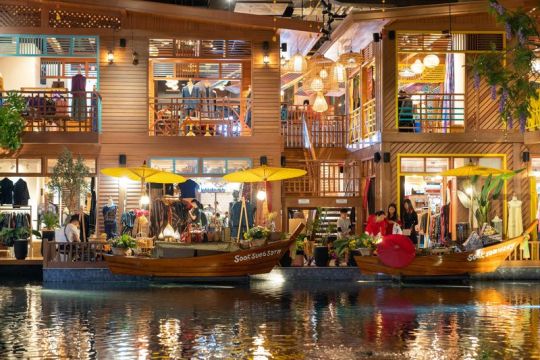
Shoppers walk past stores in the the SookSiam area inside the IconSiam megamall. Photographer: Nicolas Axelrod/Bloomberg
If you want to pretend the pandemic never happened: Head to the city’s several night entertainment districts, such as Silom (popular among LGBTQ and gay-friendly crowds), Soi Sukhumwit 11 (popular among expats and foreign visitors), or Thonglor (popular among middle- and upper-class Thais).
Officially, bars and nightclubs are still banned from operating, but many have skirted the rules by offering more fulsome menus and calling themselves restaurants, while still serving copious amounts of alcohol and hiring DJs to blast electronica.
As a precaution, some of these establishments will hand out rapid antigen tests and require a negative result before you enter.
How to Get Around
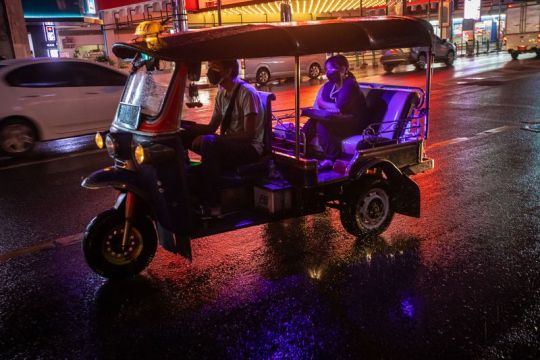
Riding a tuk-tuk is a classic way to get around the city. Photographer: Vivek Prakash/Getty Images AsiaPac
Bangkok may not be particularly walkable, but that shouldn’t prevent you from exploring al fresco. Tuk-tuks are synonymous with the city, a cultural experience unto themselves; be sure to negotiate prices before jumping in as they don’t use meters.
And the city’s colorful canals and rivers have boats that offer a good way to avoid rush hour traffic while taking in the views; some even run on electric batteries these days.
That said, taxis are often the quickest way to get from Point A to Point B. Download Grab, the local version of Uber, to hail them easily—and be sure to mask up; drivers are diligent about wearing face coverings and demanding that their patrons do the same, and some still use plastic barriers for the back seat.
A further option: The newly-expanded rapid transit system now connects the city’s two main airports and runs past all of its key attractions, from the Old Town palaces and temples to the bustling business and nightlife districts.
As with taxis, masks are required at all times and a temperature check is done at each station before you enter the system.
Covid Etiquette
When in Thailand, do as the Thais do: Wai is a Thai greeting whereby people put hands together at chest level and slightly bow their heads, and it’s a good way to minimize contact.
Bangkok is a designated "blue province," along with many other popular tourist destinations such as Phuket and Chiang Mai.
This means most restrictions have already been lifted to promote tourism activities. Still, masks are required at all times outside your place of residence. Fines for not wearing masks cost 20,000 baht (about $600).
People here take mask wearing so seriously that TV news anchors wear them during live broadcasts.
Read the full article
0 notes
Text
New warning against traveling to Thailand

Travelers to Thailand whose PCR tests return a positive are in a very high risk of being caught up in a web of rules that nobody warned them of before their departure.
The SHA+ and ASQ hotels where the travelers are required to stay, must all have contracts with a specific hospital, usually a private hospital.
If a traveler staying at their hotel tests positive, the guest has no choice but to be hospitalized at that specific hospital for 7-10 days at their own cost – usually around 10.000 THB per day.
In most cases, tourists are requested to pay upfront this amount and coordinate insurance claims by themselves later – holding the risk of not being compensated for their hospital expenses.
Sharing hotel room in close contact with a COVID patient also subjects you to quarantine 7-10 days as a high risk close contact person. This is usually not included in the insurance coverage so it would be completely at your own cost.
The PCR tests are performed by the hospital who has the exclusive rights to receive all the patients from the hotel they stay at.
You must do two PCR tests on the first day and the fifth day of your traveling, and the authorities prefer that you test both times at the same hotel.
Some travelers question, if the PCR tests follow same procedures as back in their home countries, since many find the positive result when arriving Thailand, when they just tested negative 48 hours ago before flight departure.
All travelers believe they are adequately insured because when they applied for the Thailand Pass, their health insurance was approved.
But when the traveler arrives here, it some times turns out that although the Thai embassy or consulate had accepted their insurance policy, they are not covered anyway because of the fine print in the insurance policy.
Sometimes, the insurance only covers if the patient has symptoms or is hospitalized in a hospital, not a ‘hospitel’. The Thai hospitals will keep the patient in quarantine regardless of symptoms and for the maximum days they can charge for, all solely depending on the opinion of the doctors’ team at the assigned hospital your hotel is associated with.
In other situations, it has turned out that the insurance only covers if the patient is admitted to a public hospital.
But the patient has no right to refuse to be hospitalized at the private hospital or hospitel facility which has obtained an exclusive contract with their hotel. Also in this case, the traveler will have to pay the amount at around 100.000 THB themselves.
A resident Dane in Bangkok who has been part of a network to come to the rescue of these unfortunate travelers who were trapped in this web of rules says to ScandAsia, that frankly she has come to the sad conclusion that the safest thing to do is not to fly to Thailand on a Thailand Pass until this hotel-hospital alliance is broken or the insurance policies that the embassies accept follow standards that are in compliance with these hotel-hospital contracts.
For a while, she and her network was able to extract patients with residence in Thailand from the grip of the hospitals “who only follow the rules” and transfer them to self isolation in their homes or to public hospitals, but this loophole was recently plugged.
There are so many special situations and describing them all is not possible here, she says. But she wants to add one piece of useful advice:
If you have had Covid in the past 2-3 months before your arrival to Thailand then you must remember to bring along with you PCR proof and preferably a medical recovery certificate stating your Covid history in detail with a doctor’s signature.
This documentation may help you not to become yet another unfair victim of the medical care protocol.
If you show this evidence and insist that your positive result is most likely because the test is picking up dead cells from your past infection, you may be able to avoid being detained. - Scandasia.com
Read the full article
0 notes
Text
Noisy Thailand, even the Thais are fed up with it

Surveys have shown that one of the biggest problems in #Thailand is noise pollution.
While many foreign tourists and expats think Thais just grin and bear it, the opposite is in fact true.
In terms of being an annoyance factor noise is the number one source of complaints throughout the country
A New TV story on the subject quoted a university professor as saying that nearly a third of all complaints to the authorities like the police and district authorities are about noise.
Dr Sitthidech Pongkitworasing who heads an organisation looking into the problems of the people said that noise pollution was a big issue in Thailand. It accounts for 32.8% of complaints nationwide, he said.
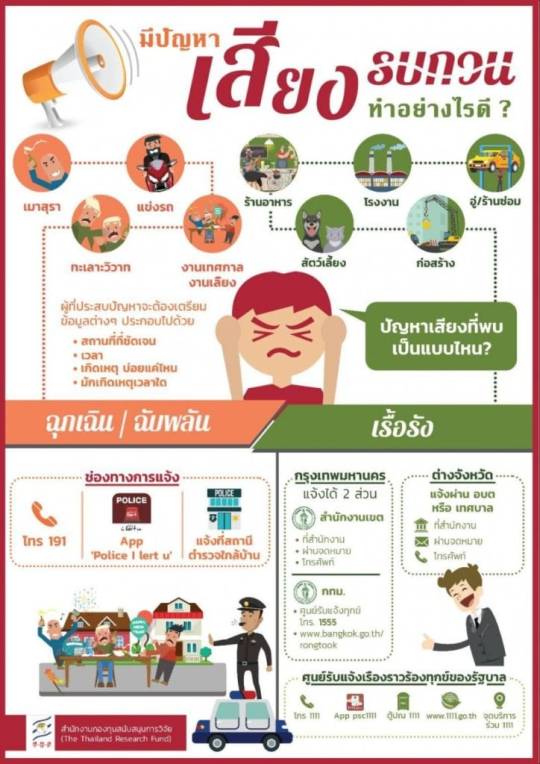
Information from the Thailand Research Fund showed where much of the aggravation comes from.
They listed:
People who are drunk
Noisy road racers
Arguments
Festivals and parties
Restaurants
Factories
Vehicle repair shops
Soi dogs and feral cats and
Construction.
These were the main culprits but there are many more.
So what could people do about it?
Advice from the Research Fund is to record when, where and how often noise occurs.
Then report it by calling 191, using the police app "Police i lert u" or contacting the local station.
If that doesn't work try contacting the district office.
In Bangkok you can call 1555 or try www.bangkok.go.th/rongtook
"Rong took" means to complain about problems you might be facing.
Read the full article
0 notes
Text
Nearly four women or children raped in Thailand every hour

A joint report published by the National Police Bureau and the National Research Institute reveals that eighty-seven women or children in #Thailand are raped every day. One in every sixteen minutes.
And those are only the reported crimes.
This is a slight increase on the figures released in 2018 which reported 30,000 rape cases per year between 2009 and 2013, an average of eighty-two per day.
Of 656 rape cases reported to the Paweena Foundation, a protection agency for women and children, the ages of the victims ranged between eighteen months and eight-five-years old. However, 60% of them were university students or school pupils.
The agency found that the rapists mainly came from three groups;
1. Step-fathers.
2. Friends of the victims.
3. Neighbours.
The foundation report concluded the reasons for violence against Thai women and children are;
1. Media influence in the shape of television scenes showing leading actors raping women.
2. The influence of drugs and alcohol.
3. Male dominance over women in Thai society.
4. Men who themselves were abused as children.
5. The vulnerability of some women in Thai society.
6. Mental instability.
7. Lack of respect for women in Thai society.
The Death Penalty does exist in Thailand for the crime of 'raping a woman or girl under the age of 15 with a gun or explosives, or with the intent to murder, is punishable by death if it results in serious injury.'
However, since 1999 an admission of guilt has only led to life in prison and early release or pardon is common. This, apparently, has resulted in fewer rapes ending in murder, in order to 'cover up the crime' in fear of being identified later. The repeat offender rate is high.
More recently there have been loud campaigns calling for the death penalty to be mandatory in rape or murder cases, especially where the victim is a child under fifteen.
The Foundation found that in many cases the rapist was educated but were able to manipulate and take advantage of women who owed them money. Most of the women were exploited by people they trusted and who they considered close.
Many victims claim they were tricked or blackmailed and, to some extent, felt forced to 'consent.'
Society as a whole is beginning to accept such violence as normal, or acceptable. Only last year a seventeen-year-old student was raped and the crime recorded on a smart phone camera by one of her so called friend. The clip was then used to blackmail the victim.
A seven-year old girl was raped and a pregnant women sexually assaulted.
A twenty-five-year old British tourist was violently raped in Pai and gave harrowing details of how the Thai police blamed her for 'drinking too much and accepting a lift.' The suspect's story, that they were a couple, was quickly accepted.
A thirteen-year-old girl was raped and then pushed off a moving train and killed by a railway worker. His defense was that he was drunk.
The railway company responded by insisting 'we must call a meeting with every side involved and will have to revise our recruitment process.'
The current legal system in Thailand does not adequately defend the victims of sexual assault and rape. Cases tend to progress very slowly until both sides have to compromise and a small financial settlement ends the matter.
Agencies committed to help victims lack resources and are unable to provide effective legal aid. And the police do not seem interested.
In one, recently reported, case an injured woman went to a police station for help only to be told there was nothing officers could do because 'the situation in the country is not normal at this time.'

Former Miss Thailand World 2014, Nonthawan 'Maeya' Thongleng called for the Death Penalty for rapists
Former Miss Thailand World 2014, Nonthawan 'Maeya' Thongleng, (pictured) displayed a poster on Instagram calling for a change in the law and commented: 'I've always thought of this. I want it (the law) changed already. Be more strict, please. #Rapistsmustbeexecuted
A petition on the online social movement website Change.org calling upon Thailand's military leader to make such a legal change attracted nearly 15,000 signatures within one day.
'The offenders, once arrested and sentenced, usually get pardoned and released from jail. And when they get out, they commit the crime again and again to the point that judicial power in Thailand is no longer sacred.' the petition read.
Col. Winthai Suvaree, a spokesman for the ruling junta, said its leader, Army Commander Gen. Prayuth Chan-ocha, urged the authorities to quickly prosecute the perpetrators and called on the relevant agencies to seek extra safety measures to prevent similar incidents from occurring.
To date, despite these figures being in the public domain since 2009, the level of sexual violence against women in Thailand has yet to decrease.
Read the full article
0 notes
Text
'Such brutality': tricked into slavery in the Thai fishing industry
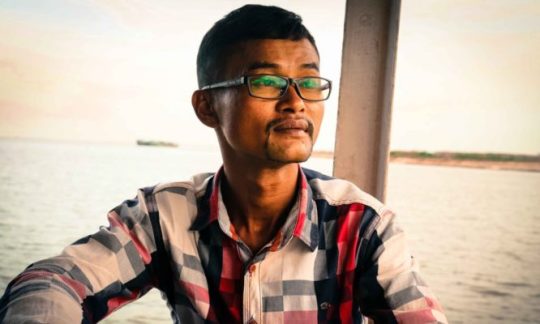
A survivor’s graphic memoir and a feature film reveal horrific exploitation and violence on the high seas – and the shame of the world’s complicity
In 2006, a young Cambodian sculptor, Vannak Anan Prum, left his village to look for labouring work.
He needed to earn enough money to pay for his wife Sokun’s impending hospital stay to give birth to their first child. He intended to be away for two months.
He would not see his wife again for five years. After a middleman on the Thai-Cambodian border promised he could earn a lot of money drying fish, Prum was sold into slave labour, sent to sea on a fishing trawler.
He was forced to work around the clock and through storms, allowed a maximum two hours’ sleep by day and two hours at night.
Violence happened on the boat every day for the next four years as a way of keeping those enslaved in line, Prum tells Guardian Australia through a translator.
He says people would disappear off the boats without warning, and were assumed to have been killed and thrown into the sea. One night, Prum says he saw one Thai worker cut another man’s head off with a cleaver.
https://bangkokjack.com/2019/10/28/trump-hammers-thai-seafood-industry/
Prum writes about and explicitly draws these horrific experiences in his new graphic memoir of modern slavery, The Dead Eye and the Deep Blue Sea.
The story includes his experience of jumping ship to attempt to swim to his escape, only to be sold by his “rescuers” into slavery on a palm oil plantation on the Malaysian coast.
His return home to his wife and the daughter born in his absence was eventually secured by LICADHO, a Cambodian human rights organisation, in 2011.
“There are many slaves who die in the ocean, and their children don’t know where they have gone,” says Prum.
“If we don’t share these stories, the world doesn’t know what’s going on in the middle of the ocean.”
The rest of the world is implicated in this slavery. Some of the “trash fish” caught by enforced labour on these boats gets used as pet food sold in supermarkets, as well as used as a cheap protein feed in prawn farming.
An estimated 200,000 migrant workers from Cambodia, Myanmar and Laos are prone to such exploitation by the $6.5 billion Thai fishing industry, according to the Raks Thai Foundation.
But the figures are hard to confirm, says Kate Kennedy, a former executive officer of Hagar Australia, part of an international organisation dedicated to restoring the lives of people broken by human trafficking.
The boys and men are typically “tricked” onto boats, says Kennedy, bonded with a debt that never goes away:
“They’re not being paid, they’re trapped on boats, and it’s particularly violent.” Ship captains use electric shock treatment, sleep deprivation and drugs to keep the labourers passive, she says.
In 2015, Hagar helped rehabilitate some of hundreds of boys and young men rescued in the Indonesian town of Benjina, which straddles two islands in the Indonesian province of Maluku, about 800 km north of Darwin.
The workers had been enslaved on Thai shipping trawlers for years, many incarcerated on the island in iron cages.
Most of those workers had seen a “demonstration murder”, says Kennedy, and post-traumatic stress is a “massive characteristic” of these victims.
Non-government organisations such as Hagar attempt to give these boys and men vocational training to repurpose their lives.
“A number ended up just going back into the fishing industry,” says Kennedy. “It was the only way they knew how to live, which was all so awful.”
Kennedy is an executive producer of a new live-action feature film, Buoyancy, by Melbourne director and writer Rodd Rathjen.
It is a story of the Thai fishing slave trade, and the characters’ experiences are based on Rathjen’s interviews with slavery survivors such as those on Benjina.
The movie, though fictional and unrelated to Prum’s slavery graphic memoir, is strikingly similar in its subject matter.
Buoyancy is naturalistic in style and uses untrained actors, including, in non-speaking roles, some who had been enslaved on trawlers “to varying degrees”, says Rathjen.
In his acting debut, Cambodian Sarm Heng plays Chakra, who is tricked onto a Thai fishing trawler where he witnesses violence, torture and murder.
Heng, a former street kid found by the casting director through Green Gecko, a non-government organisation in San Riep, was 14 at the time of filming, which took place over three weeks off the coast at Sihanoukville.
“Some of the things I asked Sarm to experience emotionally and psychologically were quite challenging for him,” says Rathjen.
“We just had to separate the acting from real life and throw our arms around him when we were finished shooting”.
Rathjen says that, speaking to survivors, he came to understand the “process of dehumanisation” that takes place on the boats, and he wants his Buoyancy audience to wonder whether the character of Chakra, also aged 14, will become violent like his captain, Rom Ran (played by Thanawut Kasro).
“I wanted to understand how you become capable of such brutality and inhumanity,” he says.
Kennedy says there has been a gradual trend in anti-slavery legislation towards supply chain reporting, commencing with California’s Transparency in Supply Chains Act 2010, and increased penalisation, with the US strengthening its powers to exclude companies from federal contracts if they fail to report on human trafficking in their supply chain.
In the UK, a recently concluded review of the Modern Slavery Act 2015 made recommendations to strengthen transparency in the supply chain, while in Australia, the Modern Slavery Act that came into effect this year compels companies turning over more than $100m per annum to report on their supply chains, with the first statements due in September next year.
Separate New South Wales legislation, not yet in effect, is expected to go further: companies with an annual revenue of more than $50m potentially face a $1m fine for slavery in their supply chain.
“The commonwealth is going for a ‘let’s expose’ first, giving companies a bit of time to get their fitness up about how they review their supply chain, because it’s not without complexity,” Kennedy says.
“There will be increasing discontent if companies are not reporting, or they’re not reporting well or taking remedy when they find slavery in the supply chain.”
The International Labour Office estimates that in 2016 there were 40.3 million people in modern slavery, including 24.9 million in forced labour (as well as 15.4 million in forced marriage).
A 2014 ILO report said there were profits of roughly $150bn a year for traffickers, consisting of $99bn from commercial sexual exploitation, $34bn in construction, managing and mining, $9bn in agriculture including forestry and fishing, and $8bn saved annually by private households that employ domestic workers under conditions of forced labour.
Vannak Anan Prum meanwhile is planning to make an animated feature based on his memoir, and his next book will be stories of other people’s slavery, including sex trafficking and women sold as brides.
“Every country must stop the slavery and human trafficking,” he says, “and private companies, please stop this exploitation.”
• Buoyancy is released in Australia on 26 September. The Dead Eye and the Deep Blue Sea is out now, published by Seven Stories Press, via Random House Australia
–
You can follow BangkokJack on Instagram, Twitter & Reddit. Or join the free mailing list (top right)
Please help us continue to bring the REAL NEWS - PayPal
Read the full article
0 notes